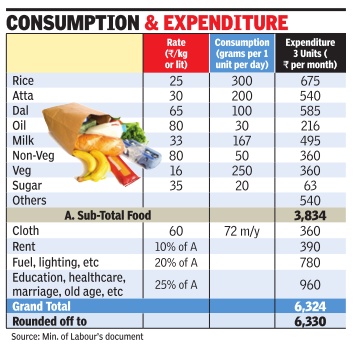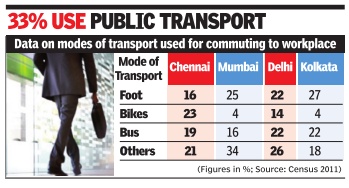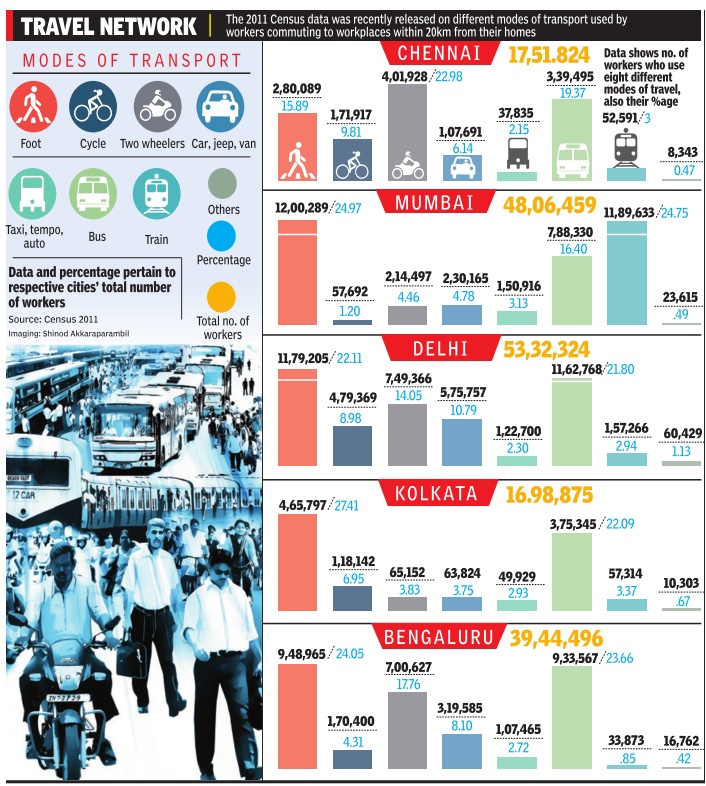Labour: India
This is a collection of articles archived for the excellence of their content. |
Contents |
2011: Literacy/ educational levels of workers, non-workers
The Times of India, Nov 07 2015
Over 130m of workforce below matric level in India In freshly-released census data on literacy status and educational levels of various types of workers and non-workers in the country , Census 2011 has found nearly 130.2 million of the total 362.6 million main workers to be literate but below matricsecondary level. The census data released on Friday -which gives the distribution of main workers by educational level and age groups -further shows that 104.3 million (28.8%) main workers are illiterates and 71.5 million (19.7%) matriculatesecondary but below graduate level.
Of about 55.5 million marginal workers seekingavailable for work in India, the majority of 21.9 million (39.4%) are illiterates followed by 20.9 million (37.6%) literates but below matricsecondary and 8 million (14.5%) matricsecondary but below graduate.
However, among 60.7 million non-workers seeking available for work in India, the major share is constituted by literates but below matricsecondary (33.6%) followed by matricsecondary but below graduate (31.1%) and illiterate (17.2%).
The decade 2001-11 exhibited 59.2 million increase in literate main workers out of which maximum increase of 20.5 million was reported under the category matricsecondary but below graduate followed by 16.2 million as below matricsecondary and 11 million as graduate and above other than technical degree.
As per overall data, only 4.5% of the country's population is educated up to the level of graduate or above while a majority 32.6% population is not even educated till the primary school level.
Those educated till primary level are 25.2%, middle school 15.7%, matric 11.1%, higher secondary 8.6% and graduate and above 4.5%.
During the decade 200111, improvement was observed at middle and above educational levels even as there was decline in percentage share at lower levels (below-primary and primary).
2015
The Times of India, Sep 04 2015

The break up justifying this figure Intercontinental Almaty as above; Graphic courtesy: The Times of India, Sep 04 2015
A labour ministry document argued that by current norms, prices and calorific needs, Rs 6330 per month is the monthly wage adequate for an unskilled worker with a wife and two small children.
The Times of India adds: How did the government calculate their proposal? A look at the fine print shows a slew of gross under-estimations and the use of an archaic formula first spelled out way back in 1957. Some of the food items' prices are far from reality . For instance dal is costed at Rs 65 but only one of the various dals in the market -chana or gram dal comes in this range. Arhar (tur) is Rs 135 per kg, urad is Rs 117.5, masur is Rs 95. All these current retail prices are from the consumer affairs ministry's price monitoring data spanning 81 cities and towns.
Commuting to work
The Times of India, Nov 12 2015

Sivakumar B
Long way to go: One in five Indians still walks to work
Well into the 21st century, more than one in five Indians walk to their work and less than 15% take public transportation. Some 33% use other modes of transport than buses and trains to reach their workplaces situated up to 20 km from their homes. Another 23% walk while 30% don't stir out of their houses but still work. These figures are based on recently released 2011 Census data on different modes of transport used by workers commuting to workplaces within 20km from their homes. Agricultural workers and domestic helps weren't considered in the survey . Of the nearly 20 crore workers surveyed, 4.5 crore walked to their workplace.
Most of those who work from home are in rural areas.“In urban areas, a large number of people who walk to work are poor. They often walk long distances in spite of inconvenient and dangerous conditions because they cannot afford any other form of transport,“ Institute of Transportation and Develop ment Policy regional director Shreya Gadepalli told TOI.
Experts see these figures as yet another reason for planners to take into account facilities for pedestrians.
In rural areas it is mainly lack of access to transport facilities that forces people to walk to work, Shreya said. The percentage of women who walk to work is even higher in urban areas.However, wide, continuous and shaded footpaths along with safe and frequent street-level crossings can entice higher-income people too to walk. Good footpaths also encourage the use of public transport,“ Shreya said. Only 11.4% workers in the country use buses and 3.5% of the workers have access to train, which includes Metro and MRTS in cities like Chennai. After foot and bicycle, the most preferred transport is twowheelers -more than 2.5 crore or 12.7% travel to their workplace by two-wheelers.
Of this, nearly 75% are in urban areas. Only 2.7% use car, jeep or van and 3% take an autorickshaw or a taxi.
“States must concentrate on developing better transport infrastructure in urban areas as a majority of workers are in cities and towns,“ said former Anna University urban engineering professor K P Subramanian. There should be better integration of multi-modal transport systems, he said. Urban authorities must discourage use of cars if there is proper connectivity between all modes of public transport, he aded.
Commuting by car
The Times of India, Nov 13 2015

Meera Vankipuram
Delhi, Chennai top in car usage, reveals data T he 2011 Census data has revealed that Delhi has the highest number of workers in the country who commute by car, jeep or van at 10.79%. Chennai is in second place with 6.14%, while Mumbai is in third place at 4.78%. Kolkata (2.93%) and Bengaluru (2.72%) have the least number of commuters who take cars or vans to work, among the five metros.
According to transport ministry data, Delhi has the highest number of cars compared to any other metro city in India. While the highly efficient Delhi Metro helped ease traffic on city roads, of late, the burgeoning peak hour crowd has made it difficult for many Delhiites to use the Metro. Between 8am and 11am on weekdays, for example, the trains carry nearly 1 lakh passengers.
Dilip Singh, 49, a general manager with a private firm in New Delhi, prefers to use metro. Of late though, many commuters drive their cars to work due to overcrowding of trains during peak hours.“Metro is not equipped to handle the massive morning and evening traffic,“ he said. Also, many Delhiites view cars as a status symbol, he said.
In Chennai, poor connectivity of public transport systems force many working professionals to use cars and vans. Rajiv Balaram, 26, who is employed at an IT firm in Sholinganallur felt that that it is impossible to get to his office without using a car or auto.“Many of us who work on the IT corridor are able to use the trains or buses only upto a certain point. After that, we depend on shared autos, cabs or cars,“ he said.
Kolkata, where less than 3% of workers drive to work, has a robust transport network that includes the metro, buses, taxis, trams and autos.This network spares commuters the need to use personal vehicles.
The city also has a strong local railway network that carries 35 lakh commuters a day . The Kolkata Metro, which serves all the major office localities of Kolkata carries 5 lakh passengers daily .Taxis carry around 16 lakh commuters a day and trams still carry around 6-7% of the daily commuter load.
This is why Kolkata was chosen by World Bank as the city with most sustainable transport system in India, said chief traffic and transportation engineer Anup Chatterjee.
Commuting by bus, train
The Times of India, Nov 13 2015
Ayyappan V Buses, first choice of many
Mumbai and Delhi have the largest number of people among cities in the country who use buses and trains to commute to work, data from the 2011 Census shows. The reason is simple: both cities have a good network of buses and trains. Of the working population in Mumbai, around 41.15% of the people use buses and trains to commute to their workplaces, while in Delhi it's 24.74%. In comparison, in Chennai, 19.37% of the workers took buses, while only 3% depended on trains to reach their work place. The share of public transport in a city should ideally be 60%.
This is why the Union ministry of urban transport has been pushing for mass rapid transit systems like metro rail and monorail in fast-growing urban cen tres.
In Mumbai, trains claim a share of 24.75% of all working people, while the share of buses is 16.4%.In Delhi, however, more people use buses because the suburban network is not convenient for residents and many of them have migrated to metro rail.
A senior railway official, who was involved in urban NOT AN EASY TRIP transit system planning, said the share of public transport had increased tremendously after metro rail extended its network across the national capital region.
Indian cities have to do a lot to make their public transport sys tems usable and reliable, especially by introducing intermodal connectivity so that people can switch from one mode of transport to another with ease during their trip from doorstep to workplace.
Binoy Mascarenhas of Embarq Mumbai, said, “Mumbai has a good track record of people using public transport. Majority of the trips for work are on public transport. Trains are the most popular while buses come second in preference.Metro rail will also have a good impact in boosting public trans port over the next 20 years when its entire network is ready.“
The reason for change in volume of patronage varies from city to city-from geography to poor capacity and poor connectivity . The choice of transport system depends on the nature of the city . Mumbai's linear geography makes trains the choice while that may not be the case with cities like Bengaluru and Delhi.